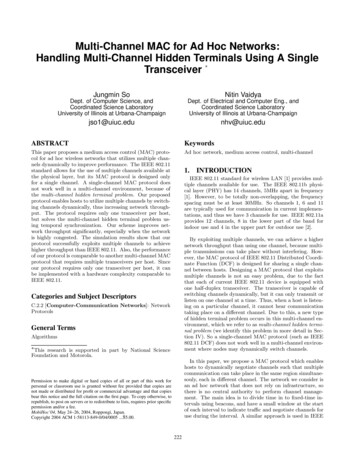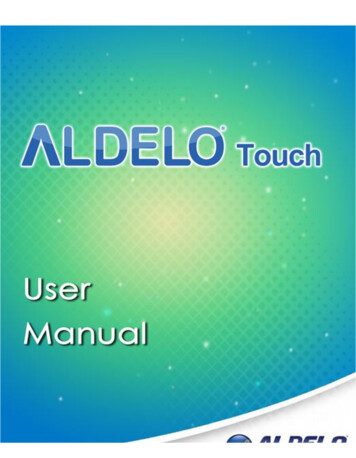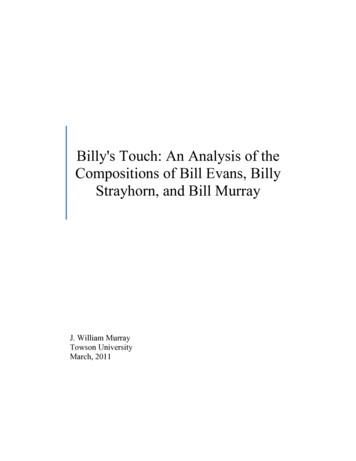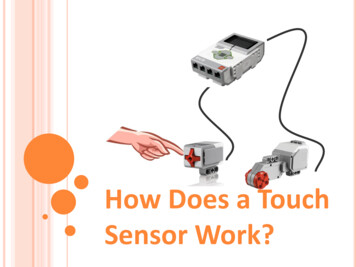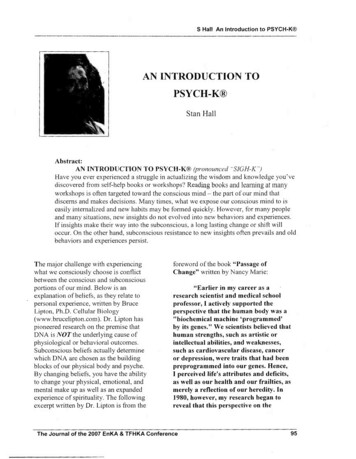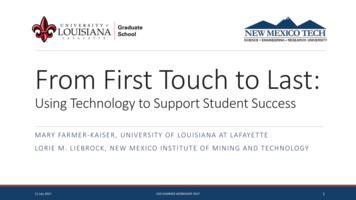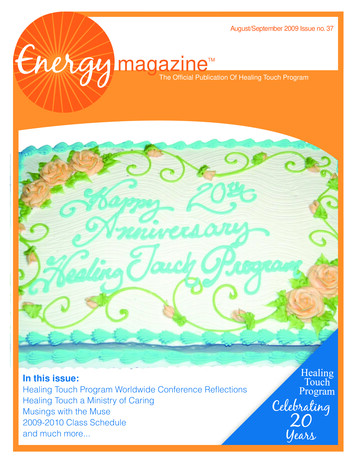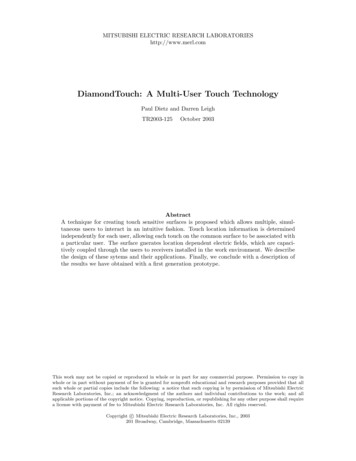
Transcription
MITSUBISHI ELECTRIC RESEARCH LABORATORIEShttp://www.merl.comDiamondTouch: A Multi-User Touch TechnologyPaul Dietz and Darren LeighTR2003-125October 2003AbstractA technique for creating touch sensitive surfaces is proposed which allows multiple, simultaneous users to interact in an intuitive fashion. Touch location information is determinedindependently for each user, allowing each touch on the common surface to be associated witha particular user. The surface gnerates location dependent electric fields, which are capacitively coupled through the users to receivers installed in the work environment. We describethe design of these sytems and their applications. Finally, we conclude with a description ofthe results we have obtained with a first generation prototype.This work may not be copied or reproduced in whole or in part for any commercial purpose. Permission to copy inwhole or in part without payment of fee is granted for nonprofit educational and research purposes provided that allsuch whole or partial copies include the following: a notice that such copying is by permission of Mitsubishi ElectricResearch Laboratories, Inc.; an acknowledgment of the authors and individual contributions to the work; and allapplicable portions of the copyright notice. Copying, reproduction, or republishing for any other purpose shall requirea license with payment of fee to Mitsubishi Electric Research Laboratories, Inc. All rights reserved.Copyright c Mitsubishi Electric Research Laboratories, Inc., 2003201 Broadway, Cambridge, Massachusetts 02139
Published in Proceedings of UIST 2001, the 14th Annual ACM Symposium on User Interface Software and Technology, November 11-14, 2001, Orlando, Florida USA, pages 219-226.
DiamondTouch: A Multi-User Touch TechnologyPaul Dietz and Darren LeighMitsubishi Electric Research Laboratories201 BroadwayCambridge, MA 02139 USA 1-617-621-7500fdietz,leighg@merl.comABSTRACTA technique for creating a touch-sensitive input device is proposed which allows multiple, simultaneous users to interactin an intuitive fashion. Touch location information is determined independently for each user, allowing each touch ona common surface to be associated with a particular user.The surface generates location dependent, modulated electric fields which are capacitively coupled through the usersto receivers installed in the work environment. We describethe design of these systems and their applications. Finally,we present results we have obtained with a small prototypedevice.KEYWORDS: DiamondTouch, multi-user, touch, collaborative input, single display groupwareINTRODUCTIONDiamondTouch is a multi-user touch technology for tabletopfront-projected displays. It enables several different peopleto use the same touch-surface simultaneously without interfering with each other, or being affected by foreign objects.It also allows the computer to identify which person is touching where.During the course of research on Human-Guided SimpleSearch [1] some of our colleagues have constructed a collaborative workspace in which multiple users work on the samedata set. The environment consists of a ceiling-mountedvideo projector displaying onto a white table around whichthe users sit. A single wireless mouse is passed around asdifferent users take the initiative. Our colleagues proposedthat the collaboration would be improved if the users couldindependently and simultaneously interact with the table, andconsidered using multiple mice.The use of multiple mice in a collaborative environment isparticularly problematic. It can be challenging for users tokeep track of one pointer on a large surface with lots of activ-Figure 1: The collaborative work environment forHuman-Guided Simple Search.ity. Keeping track of many mice is nearly impossible. Thisleaves users physically pointing at their virtual pointers totell other users where they are. Also, relying on a separatephysical device keeps us from utilizing the natural humantendencies of reaching, touching and grasping. 1Using a large touch-screen as the table surface would seemto be an answer, but existing touch technologies were inadequate. Most allow only a single touch and do not identifyusers. While schemes have been developed where users taketurns [3], we wanted the interaction to be simultaneous andspontaneous.Unlike electronic whiteboards or other vertical touch systems, the tabletop nature of our display creates a problem:people tend to put things on tables. With a pressure-sensitivesurface, foreign objects create spurious touch-points causingsingle touch systems to malfunction.Optimally, we would like a multi-user touch surface to havethe following characteristics:1 Plus see the discussion in [2] for advantages of touch tablets over mice.
ProjectorinsulatinglayersubstrateantennasFigure 3: A set of antennas is embedded in the tabletop. The antennas are insulated from each other andfrom the users.transmitterreceiverreceivercomputerFigure 2: DiamondTouch works by transmitting signals through antennas in the table. These signals arecapacitively coupled through the users and chairs toreceivers, which identify the parts of the table eachuser is touching. This information can then be used bya computer in the same way as mouse or tablet data.1. Multipoint: Detects multiple, simultaneous touches.2. Identifying: Detects which user is touching each point.3. Debris Tolerant: Objects left on the surface do not interferewith normal operation.4. Durable: Able to withstand normal use without frequentrepair or re-calibration.5. Unencumbering: No additional devices should be requiredfor use – e.g. no special stylus, body transmitters, etc.6. Inexpensive to manufacture.The DiamondTouch technology meets all of these requirements. In the following sections, we describe its operatingprinciples, the sorts of interactions that are possible, and theresults of our experience with a small prototype device. Wealso present some ideas for future work and applications.DiamondTouchDiamondTouch works by transmitting a different electricalsignal to each part of the table surface that we wish to uniquelyidentify. When a user touches the table, signals are capacitively coupled from directly beneath the touch point, throughthe user, and into a receiver unit associated with that user.The receiver can then determine which parts of the table surface the user is touching.The table surface is a constructed with a set of embeddedantennas which can be of arbitrary shape and size. The antennas are thin pieces of an electrically conductive materialwhich are insulated from each other. Since the coupling ofsignals to the users is done capacitively, the antennas are alsoinsulated from the users, and the entire table surface can becovered by a layer of insulating, protective material as shownin Figure 3. Each antenna extends over a single area of thetable to be unambiguously identified: the system cannot tellwhere on the antenna a user touches, just that the user touchesthat antenna. A transmitter unit drives each antenna with itsown signal that can be distinguished from the signals of theother antennas. Users are capacitively coupled to their receivers through their chairs, and the receivers are connectedback to the transmitter through a shared electrical ground reference.When a user touches the table, a capacitively coupled circuitis completed. The circuit runs from the transmitter, throughthe touch point on the table surface, through the user to theuser’s receiver and back to the transmitter.With proper design, capacitive coupling [4] through the human body [5] can be quite reliable. The first consideration isthat we wish to operate via “near field” (i.e. capacitive) coupling. By limiting the transmitting frequencies so that thedimensions of the entire system are very short compared to awavelength, very little energy is radiated. This reduces problems with radio frequency interference and with unwantedcoupling between the antennas. For reasonably sized tables,frequencies should be in the sub-MHz range. 2The system can be understood with the aid of a simplifiedequivalent circuit as shown in Figure 4. C table represents thecapacitance between the user’s finger and a transmitting antenna in the table. C chair represents the capacitance betweenthe user and a conducting chair. The coupling capacitance is2 At a frequency of 1 MHz, the wavelength is about 300 meters.
UNIQUE SIGNALSCtable -CchairtransmitterBecause a user may touch several antennas at once, it is important that the receiver be able to distinguish between andidentify any mix of incoming signals. We can do this if thesignals are “separable”, or in signal processing terms “mutually orthogonal”.receiverFigure 4: The equivalent circuit for the DiamondTouchsystem.the series combination of these two capacitances:Ccoupling CtableCtable CchairCchairSince the coupling area of a finger is very small comparedto the entire body in a conducting chair, C table tends to bevery small compared to C chair . Thus, the equation reducesto Ccoupling Ctable . This means that the precise capacitivecoupling via the chair is inconsequential, as long as it is largeenough. If it were desirable to have the users stand on conductive floor plates instead of sitting in conductive chairs, thecoupling area would be substantially smaller, but still verylarge compared to a finger. Experience has shown that eventhick-soled shoes do not present a problem in this scenario.When a user’s finger is far from the table, C table is very smalland little or no signal is coupled from the transmitter to thereceiver. As the user’s finger approaches the table, C tableincreases, the coupling to the receiver increases and so thereceived signal strength increases. The signal strength is alsoproportional to the area of the touch: using a thumb or theheel of a hand will produce a higher received signal strengththan using a little finger.DiamondTouch requires reasonable electrical isolation between the users. This constraint is violated if two or moreusers (or their chairs) are touching, or are in very close physical proximity. In this regard, social norms of “personalspace” have been sufficient to keep the inter-user couplingacceptably small. However, this behavior can be explicitlyexploited. By touching another user (or their chair), thetouches of either user are interpreted as touches for bothusers. Typically, the coupling “through” a second user issomewhat weaker, and so it is usually possible to determinethe “primary” user versus “shared” users. This provides asimple and intuitive mechanism for users to jointly indicatea selection.There are many ways of generating such signals. 3 For example, each antenna could be driven with a sinusoid of a different frequency. A receiver that is coupled to several antennascould determine which ones they are by examining the frequency spectrum of the received signal. Unfortunately, generating the numerous frequencies required for a large array iscomplicated and relatively expensive, so we rejected simple“frequency-division multiplexing” in our prototype.Time-division multiplexing is another option. In this case,each antenna is separately driven in turn by a given signalwhile the other antennas are not. The timing of the receivedsignals is used to determine which antennas are coupled tothe receiver. While this system is very simple to implement,it may not be appropriate for larger arrays. The problem iscaused by the interplay of various constraints. To providegood response time, the entire array must be scanned 10 to100 times per second. However, as noted previously, practical modulating frequencies are limited to the sub-MHz range.This leaves very few modulation cycles per antenna, makingreceiver design difficult, especially in the face of other interfering noise sources. There are some clever ways of reducing the scan time [6] that help to extend the practicalityof time-division multiplexing schemes, but these are beyondthe scope of this paper.Another way to construct a set of orthogonal signals is bycode-division multiplexing, which is a spread spectrum technique. In fact, this turns out to be a particularly elegant approach for large arrays because very simple hardware operations (shifts, XORs, etc.) can be used to generate the largenumber of spreading codes. The simple hardware can evenbe cascaded, so that smaller touch devices can be tiled tomake much larger ones. The spread spectrum approach willactually provide a significant gain in signal-to-noise ratio forlarge arrays.ANTENNA PATTERNSAs we stated before, the antennas embedded in the tabletopcan be of arbitrary shape and size. A designer may choose toimplement just a few large “buttons” or a much more complicated array. Of course, a general, configurable solution ismore desirable than a particular one that is designed into thehardware.The most general solution is a “full matrix” pattern, in whicha very large number of antennas are arranged in a rectan3 A concise explanation of these various types of multiplexing can befound in [7]. For more general information on orthogonal signals, andspread spectrum information, see [8].
pling. This leads to an interesting use of the device – a single user might touch two points to define a bounding box.This is a very natural way of selecting a rectangular area. Inpractice, we have found two modes of operation to be useful: when the coupled area is small, assume that the user isindicating a point. When it spans a larger area, assume thatthe user is trying to specify a bounding box. The end resultis that even this simplified row/column design allows somemulti-touch capability for single users. 4PROTOTYPEFigure 5: The row-column antenna pattern that ourprototype uses. Each row or column is composedof diamond shapes connected in one direction andisolated in the other. This allows the maximum surfacearea for both layers without the upper one shieldingtoo much of the lower one.gular grid. Such a matrix of individually driven antenna“pixels” allows an unambiguous determination of multipletouch locations, even for a single user. Unfortunately, this isalso the most difficult pattern to manufacture due to the verylarge number of connections required and the correspondingly large amount of supporting circuitry. In reality, the fullmatrix pattern may be unnecessary for many applications.Although the simultaneous, multi-user feature is essential, itis usually sufficient for each user to indicate at most a single touch point or bounding box. This functionality can beobtained with a simple row/column pattern that drasticallyreduces the number of antennas.The rows and columns will usually be on two different layers. Due to shielding effects, there is some subtlety to creating a good row/column antenna pattern. A simple rectangular pattern of columns on the upper layer will overlap andcover too much of the equivalent set of rows on the lowerlayer. This will decrease the amount of area through whichthe rows can capacitively couple signals, weakening theirsensitivity. A good antenna pattern will minimize the areain which the rows and columns overlap, while maximizingtheir total areas. We have found the connected diamond pattern shown in Figure 5 to be a good choice. This pattern hasthe interesting property that the row conductors are identicalto the column conductors, rotated ninety degrees. In our prototypes, this allowed us to create a single conductor patternand use it for both rows and columns, saving manufacturingcosts.In use, a touch will most likely span multiple rows andcolumns with different degrees of coupling. The receivedsignal strengths can be used to estimate a centroid for thetouch, obtaining positioning finer than the row and columnspacing. However, an alternative way of using this information is to present a bounding box for the touch event, definedby the outermost rows and columns that have significant cou-In order to test these concepts, we have created a small DiamondTouch prototype, part of which is shown in Figure 6.The prototype has an active area of approximately 20 cen-Figure 6: Part of the prototype’s antenna array. Compare with Figure 5.timeters by 20 centimeters containing 80 antennas arrangedas 40 rows and 40 columns. The half-centimeter pitch waschosen so that a typical finger touch would span at least tworows and two columns. A 0:5 millimeter thick double-sidedprinted circuit board was designed to be either the row or thecolumn array, depending upon the rotation. Since we wouldlike the coupling to either rows or columns to be about thesame, the boards were arranged with the antenna arrays sandwiched in the middle of the stacked row and column boardswith a very thin insulator in-between. Thus the gap to the topsurface was very similar, varying only by the thickness of theinsulator.The antenna arrays are driven by a transmitter board that appears in Figure 7. For the moment, we have implementedtime-division multiplexing where each antenna, in turn, isdriven with 10 cycles of a 100 kHz square wave. While thisboard is capable of driving the antennas with a 60 volt swing,4 Of course, it would be better if a row/column pattern could distinguishmultiple touches from a single user. The problem is that, given two Xand two Y coordinates, the system cannot tell if the intended touches are(X 1; Y 1) and (X 2; Y 2) or (X 1; Y 2) and (X 2; Y 1). In most cases, timing information might be used to disambiguate the two cases. If you had(X 1; Y 1) and then (X 2; Y 2) appeared later, you could safely guess thepairings. A case where this method fails is if the two touch points cometogether and then separate.
and send them in raw form to a PC via fast RS-232 serialconnections. There is a separate receiver board for each user.The entire table is scanned 75 times per second and the PCreceives a coupling value for each user for each row and eachcolumn. The 75 Hz update rate and negligible latency to thecomputer allow the prototype to be very responsive.Figure 7: The prototype’s transmitter board basedaround a PIC microcontroller. It is small and uncomplicated.The table is considered to be “touched” when the receivedsignal at an antenna is high enough. In theory, we coulduse a simple threshold to determine this. However, givencomponent drift, user variations, and varying noise levels,we have found it more practical to adapt a threshold basedon current estimates of minimum coupling and noise levels. This works satisfactorily, but more sophisticated methods may yield better results. A problem case arises when therubber-footed chairs are dragged across the carpet. “Staticelectricity” causes large noise spikes that require better filtering.we have found 5 volts to be quite sufficient. Using a highervoltage produces a better signal-to-noise ratio which can beuseful in electrically noisy environments.The transmitter and receiver boards are based on PIC microcontrollers and other inexpensive, off-the-shelf electronic components. The most expensive parts we used were the printedcircuit boards for the table itself, and these would be muchcheaper in a massed produced product.The receivers are attached (via shielded cables) to padded,folding metal chairs that serve as the user coupling devices.Just about any conductive chair can be used for this application as long as there is sufficient capacitive coupling betweenthe occupant and the receiver cable. Non-conductive chairswill work if a conductive “cushion” (a layer of metal foil,perhaps padded for comfort) is used to couple the user to thereceiver.We have written test software that generates a bar graph display of the coupling level, for each row and column and eachuser, along the appropriate axes. Different colors are usedfor each user. The calculated touch points are graphicallydisplayed: a cross-hair cursor is shown for small touch areas,and a bounding box is show for larger ones.Figure 8 shows one of the prototype receivers. For m
KEYWORDS: DiamondTouch, multi-user, touch, collabo-rative input, single display groupware INTRODUCTION DiamondTouch is a multi-user touch technology for tabletop front-projected displays. It enables several different people to use the same touch-surface simultaneously without inter-feri
